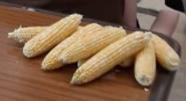Who doesn’t love a tasty ear of corn, fresh from the field? It can be a little messy, but boy, is it worth it!
Wouldn’t it be great to be able to keep that tasty goodness throughout the year? Actually, in a way, you can!
While some people like to take the quick and easy way out and freeze ears of corn whole, blanching and cutting corn off the cob has some definite benefits.
There’s kind of a science to it, and it works better if you have your system ready. I was reminded of that recently, when we got a pickup truck load of corn in last week. The Wald family from East Grand Forks always generously plants a section of their land in sweet corn for us. Mid-August, we have come to expect a phone call say that the corn is ready, and asking when they can bring it in.
We used to usually bag the corn raw on the ear, and freeze it that way. This year, we went a different route. Many of our residents have dentures and have trouble eating it off the cob. Also, cutting it off the cob saves a lot of freezer space! Blanching kills enzymes that diminish corn quality over time in the freezer, so that’s what I did.
In this blog, I’ll share some things I’ve learned from reading, experience, and even insight from others, in case you’ve got some extra corn you’d like to put up for winter enjoyment.
When I was a kid, our family friends on a farm south of us had an abundance of corn to salvage. We picked a bunch and formed an assembly line: husking, blanching, and cutting it from the cobs. I remember my mom putting the kettles in the bathtub of cold water to cool!
Fast forward quite a few years…(and yes, I have done corn in the meantime!)
Last week, we got all the corn husked and de-haired by around 10 in the morning. Beforehand, I marked several zip baggies: “Corn – 8-16-21, so I could save time and hassle later.
I got two big kettles of water boiling and added several ears (about 8 or 9) of corn to each one. I am learning that I maybe shouldn’t do so much corn at a time because it took a while to return to boiling. Once it was rapidly boiling again, though, I timed it for 3-4 minutes before turning off the burner and putting the ears into an ice bath I had prepared.
The ice tended to melt quickly, unfortunately, because it was crushed ice from the kitchen. I had to make multiple trips back and forth for fresh ice during my corn blanching marathon. I kept dumpling and refilling a large plastic bin we have on hand for bussing dishes.
After the fact, a friend of ours said that she used to fill cardboard milk cartons with water to freeze for this purpose. I’m going to try this next time! Larger ice chunks won’t melt so quickly. The purpose of the ice water bath it to stop the cooking process on the corn that has been removed from the blanching kettle. Another idea I found is to fill plastic bags with water and freeze them. I’m trying this also. This should make my life easier tomorrow when I attack another batch of corn that came in.
Now, for the cutting process! A trick I have found very helpful, which our former activity assistant told us about, is resting your ear of corn on the middle of an angel food cake pan, and cutting the corn off that way. It really works slick! Another person who was helping us last time used an electric knife to cut off the corn. This worked well for her.
After we got a bunch of corn cut off, I would scoop it into gallon sized double seal freezer bags, and seal, trying to push as much air out as possible. It was kind of juicy, and I also avoided getting excess fluid in there.
I read somewhere that you can create more of a vacuum seal by submerging the bag in a bowl of water with just a small space in the zipper unsealed. This didn’t work well for me, though, because the bags, filled with corn, were more bulky than flat. Tomorrow, I might try and see if I can’t flatten the filled bags out more.
Most people don’t freeze corn in gallon size bags, but when you’re serving 30-40 people at a time, it makes sense.
If you’re doing smaller bags, a trick one can try is freezing them flat on a cookie sheet, which saves space later. You can just take them off the cookie sheet once they’re frozen and put them in a plastic grocery bag.
One thing to keep in mind when freezing corn is not to put too much in a small freezer at once, as the freezer will be overworked.
I hope some of this is helpful to you if you decide to get corny this summer!


